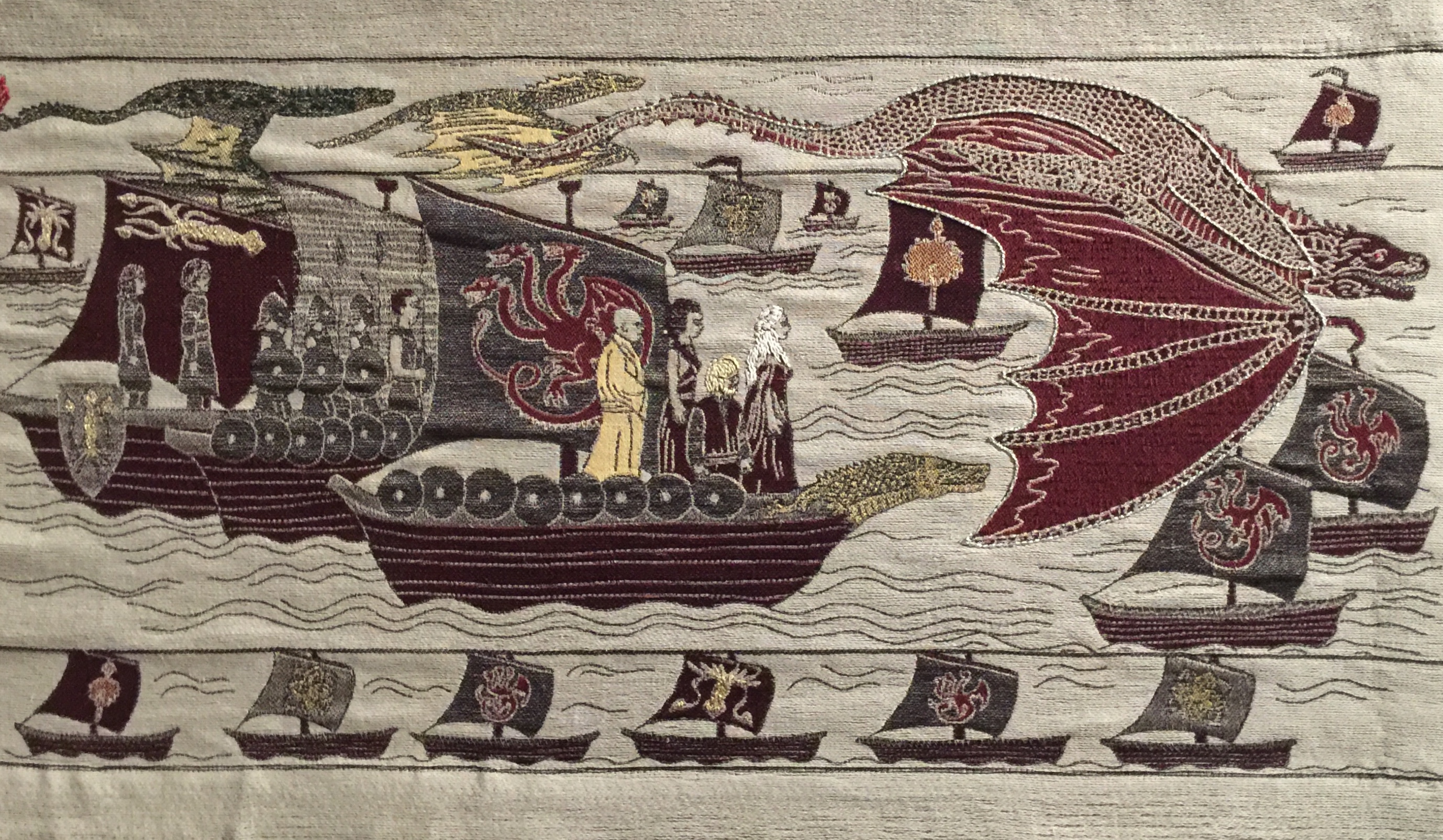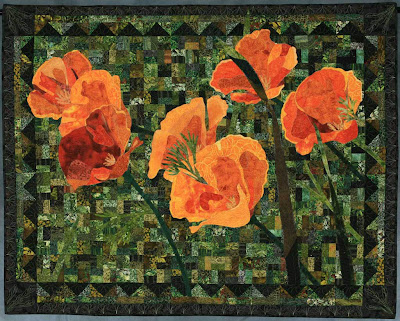UK Textile Tour Day 9: Audrey Walker at the Ruthin Craft Centre – Wales
One week before I was scheduled to leave on my trip, I received my “Embroidery” magazine, the publication from the UK’s Embroiderers’ Guild. To my surprise, an article highlighted an upcoming exhibition at the Ruthin Craft Centre in Northern Wales of Audrey Walker’s amazing embroideries. And it was opening one day after I was scheduled to drive North through Wales up to Scotland!

Christina Fairley Erickson with Audrey Walker’s “Adam” and “Eve” stitched textiles (2000) and drawing study for “Eve”. Adam and Eve each approximately 16″ w x 40″ high (the embroidery). On loan by Graham Holland.
As an artist who does a lot of pictorial work, I’ve been a fan of Audrey Walker’s work ever since my mentor and tutor, Gail Harker, introduced me to Audrey’s intricate stitched portraits. So, without much hesitation, I worked out a change in my itinerary to stay an extra day in Wales, so I could see the exhibition on its opening day.

Detail from “Eve” by Audrey Walker 2000.
Audrey Walker’s six-decade long career in embroidery has influenced many contemporary embroiderers. Not only is she an amazing artist in her own right, she succeeded Constance Howard as the head of the Goldsmith’s College Embroidery & Textiles Department (1975-88) guiding another generation of makers. She focused on teaching her students to seek out and explore their ideas first, then to study the history and techniques to realize their artistic vision. Her first textile associate was Jan Beaney, who went

“The White Tulips” by Audrey Walker 2012 (approximately 48″ h x 16″ w). On loan from the Embroiderers’ Guild UK
on to become internationally renowned for her stitchwork, as well as being one of the Cities and Guilds tutors and evaluators who taught Gail Harker. So, I guess I can claim Audrey is my embroidery great-grandmother!

Detail from “The White Tulips” 2012 by Audrey Walker
This exhibition, in Audrey’s 90th year, is a retrospective of her work, with pieces coming from as far away as the U.S. (owned by private collectors) brought together at the Ruthin Craft Centre, the location of Audrey’s first solo exhibition 18 years ago.
Audrey’s start in textiles began ten years after completing her degree in fine art (mainly portrait painting), after seeing an exhibit of fabric collages by Margaret Kaye (1912-2002). Prior to that , Audrey associated embroidery with the domestic textiles of her youth. Rather than continuing on as a painter, textiles became Audrey’s medium of choice. She even incorporated some of her family’s domestic textiles into her artwork, giving a nod of recognition to the historic roots of embroidery.

“A Cumbrian Birthday” 1997/8 by Audrey Walker uses a tray cloth from Audrey’s childhood. The embroidery (approximately 30″ w x 20″h) represents the Cumbrian tradition of offering guests a class of port and cream crackers with rum-butter on the best china, when visitors came to see a newborn baby.
Topics that have figured prominently in Audrey’s work include “momentary glances, encounters, inward smiles, the power of a gaze, vulnerability and the simple pleasures of life”. Some of her figures have a wistful, enigmatic look or smile, reminiscent of the Mona Lisa. Audrey’s process includes drawing portraits prior to her stitching and even drawing at the end of a day of stitching as a critique of her work or to an express an idea to develop in the future.

“Beach Woman” by Audrey Walker 1996, approximately 36″ h x 28″w. The larger-than-life size was to be suggestive of ‘heroes’.

Embroidery detail from “Beach Woman” by Audrey Walker 1996. Machine and hand stitched.
It’s remarkable to see the incredible detail that has gone into each of these large pieces. The images are created through color blending with the threads.
“There is no doubt that building up an image with absolutely separate lines of colour – the threads – is an endlessly fascinating and pleasurable activity. But it can be infuriatingly slow and it has all kinds of hazards! …However, the very slowness of the process can be productive. It allows a longer encounter with the idea and therefore the chance to explore it more fully and critically. It offers opportunities for valuable interludes – for instance setting a large piece on one side for a time in order to work through related thoughts on a smaller scale or in a different medium. The prooblems in the larger piece are often solved through side-stepping into related work.” (Audrey Walker ‘Insights’, 1999.)

“Encounter” 1998 by Audrey Walker approximately 36″h x 54″ w. Originally intended as two separate pieces, Audrey reworked the piece through drawings and small embroideries to overlap the images.

Detail of hand-stitched eye from “Encounter” by Audrey Walker 1998.
Audrey was a regular participant in the “62 Group” exhibitions from 1966 – 1981. Starting in 1962, the 62 Group of Textile Artists was created as support for serious professional textile artists. Audrey joined in 1964 and remains an Honorary Exhibiting member.

“Observed Incident” by Audrey Walker 2002. Approximately 28″ w x 60″ h (each panel). On loan from the Crafts Council.

Detail of knight’s face with helmet and shield from “Observed Incident”.

Detail of “Still Life” by Audrey Walker, 1993
Inspired by a tiny embroidery fragment less than 2″ high at the Victoria and Albert Museum, Audrey created “Observed Incident.” The 14th Century inspiration had 3 knights in full armor with a watching figure. She wished to salute the unknown embroiderer’s imagination with a large scale version of the topic.

“Still-life” by Audrey Walker 1993 includes a tribute to Marandi, a master of still-life. Aprroximately 48″ w x 28″ h. On loan by Jan Beaney and Steve Udall.

“Stop and Smell the Roses” by Audrey Walker 2004. Approximately 14″w x 20″ h. On loan by Jean Littlejohn.

“Life is Just a Little Bowl of Cherries” by Audrey Walker 1984. Approximately 20″w x 15″ h. On loan by Jan Beaney and Steve Udall. Ground is a tablecloth c 1935 to celebrate Audrey’s mother’s domestic embroidery. One of a series on this theme.

Detail “Stop and Smell the Roses” by Audrey Walker 2004

Detail “Life is Just a Little Bowl of Cherries” by Audrey Walker 1984.

“The Big Blue Bowl” by Audrey Walker 2013. Approximately 24″w x 18″ h.

Detail “The Big Blue Bowl” by Audrey Walker 2013.
The Big Blue Bowl is part of Audrey’s recent body of work where she is experimenting with a single line of stitch, rather than overlapping stitches.

Detail “The Garden” by Audrey Walker 2012.

“The Garden” by Audrey Walker 2012. Approximately “52” w x 48″ h.

“Early Landscape” (1960’s) by Audrey Walker. Approximately 24″ w x 22″ h. On loan by Jan Beaney and Steve Udall

“Gaze IV” by Audrey Walker 1999. Approximately 14″w bottom; 11″ w top x 14″ h. On loan by Diana Springall.

Detail of Goldwork and Embroidery in “Gaze IV” by Audrey Walker 1999.

Christina with “Temptation (The Collectors)” by Audrey Walker 2004. Approximately 36″ x 36″ On loan by Diane & Marc Grainer, USA.
Once in a while you need to give in to temptation… as I did by going out of my way to make it to this exhibition. I’m so glad I did!





































 The tapestry was designed by hand by illustrators and color artists Carim Nahaboo, Jacob Merrick-Wolf, and Rob House. The weavers, Juliet Bailey, Franki Brewer, and a team at Dash & Miller in Bristol used a state-of-the-art jacquard loom. The linen thread was provided by Thomas Ferguson Irish Linen in Banbridge, one of the last surviving mills in Northern Ireland, and contains over 250,000 threads placed by hand.
The tapestry was designed by hand by illustrators and color artists Carim Nahaboo, Jacob Merrick-Wolf, and Rob House. The weavers, Juliet Bailey, Franki Brewer, and a team at Dash & Miller in Bristol used a state-of-the-art jacquard loom. The linen thread was provided by Thomas Ferguson Irish Linen in Banbridge, one of the last surviving mills in Northern Ireland, and contains over 250,000 threads placed by hand.












